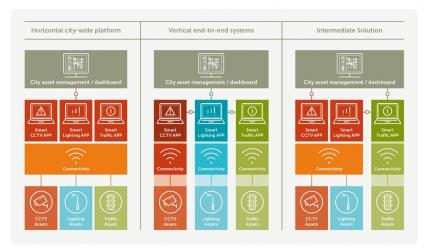The paper advocates an open systems approach to the development of smart cities to ensure the maximum degree of interoperability between cities and their systems.
Jeremy Green, one of three authors of the white paper and principal analyst at Machina Research, has seen system integrators not delivering on smart city platforms, promising pilots and the linking of data.
The white paper states that this could be due to the problems surrounding proprietary technologies designed for one particular function. To challenge this, the white paper advises that the introduction of new technology-based systems can be maximised by adopting a holistic, rather than a silo-based, approach.
“Open standards are good, but when you can’t have open standards because they’re not available, developed yet or take too long, then you take a layered approach with open interfaces between the layers,” added Green.
“In the Smart Cities of tomorrow, more than in any other typical IoT deployments, openness and interoperability are key, for three reasons,” said Remy Marcotorchino, Sierra Wireless’s smart city expert and director of marketing, who contributed to the report. “First, in the short-term, it allows a drastic reduction of deployment and operation costs, by means of sharing and reusing a common infrastructure and field equipment such as communication equipment, sensors, interfaces.
“Second, in the mid-term, it guarantees the sustainability of the investments by avoiding vendor lock-in and favoring competition.
“Third, long-term, it permits improved and unforeseen opportunities. By having solutions based on established standard protocols, new applications will also be able to plug in more easily rather than having to re-create solution from scratch, and the availability of the data for these new applications may enable completely new use cases and business models.”
The report gives three options for connecting smart city applications, which are underpinned by edge devices exchanging data with a back-end IT system.

The first option is a ‘horizontal city-wide platform’ where various applications are developed on a common connectivity platform, requiring the city to specify the platforms to be used. The second is a ‘vertical end-to-end system that “envisages” applications being able to integrate with each other through open APIs and a city management platform. Option three assumes that a single vendor is responsible for supporting multiple applications.
Sierra Wireless views the best method of connecting applications as one that avoids vendor lock-in and can leverage multiple connectivity infrastructures such as Wi-Fi, cellular and cellular LPWA. It views a future-proof smart city strategy as one that allows ease of deployment of new applications or sensors through open API and standards.
Marcotorchino says that as a city authorises the release of open data and makes it more available – with respect to privacy and opt in – more services can be created and a solution providers’ ecosystem can grow, resulting in new revenue streams and services.
“Layering the infrastructure and thinking in terms of horizontal common layers is a first very important step," added Marcotorchino. "Then, the notion that every layer should be agnostic to the layer below it, for example the horizontal service platform being agnostic to the connectivity, is another important element. Finally, choosing open and recognised standards within these layers as well as between the layers is the final element that will guarantee and open and durable system and infrastructure.”
The benefits of three different types of interfaces, based on the different architectures, have been identified by the whitepaper. The ‘City Management Interface’, which provides the overall “dashboard” and mediates between the system-facing and administrative aspects of the application. A ‘Inter-Vertical Interface’, which allows the direct exchange of data between verticals and ‘Intra-Application Connectivity’, which enables interoperability between providers of software and hardware within a given application.
Andreas Knobloch, Philips Lighting’s alliance manager, comments in the whitepaper that the Inter-Vertical Interface is the “most rapidly evolving” of the interfaces. The white paper says that smart verticals are able to realise much stronger effects when interconnected, with added value coming from improvements in the quality of public service delivery.
“Cross-vertical interfaces are the next area of growth, and [they’re] only just starting to evolve today,” added Knobloch. “There is a requirement for a broader horizontal view across vertical applications. This will account for more and more value over the next ten years.”



